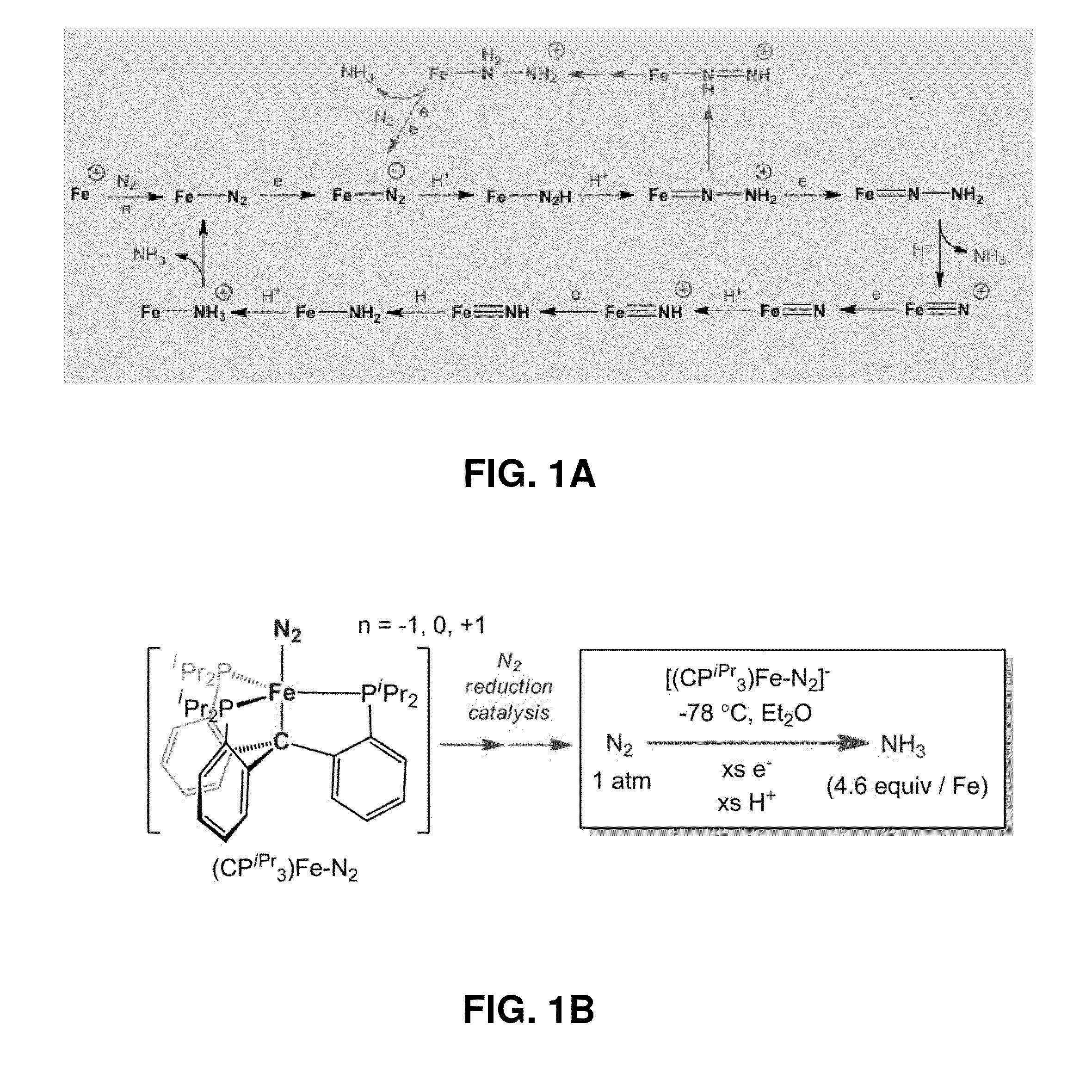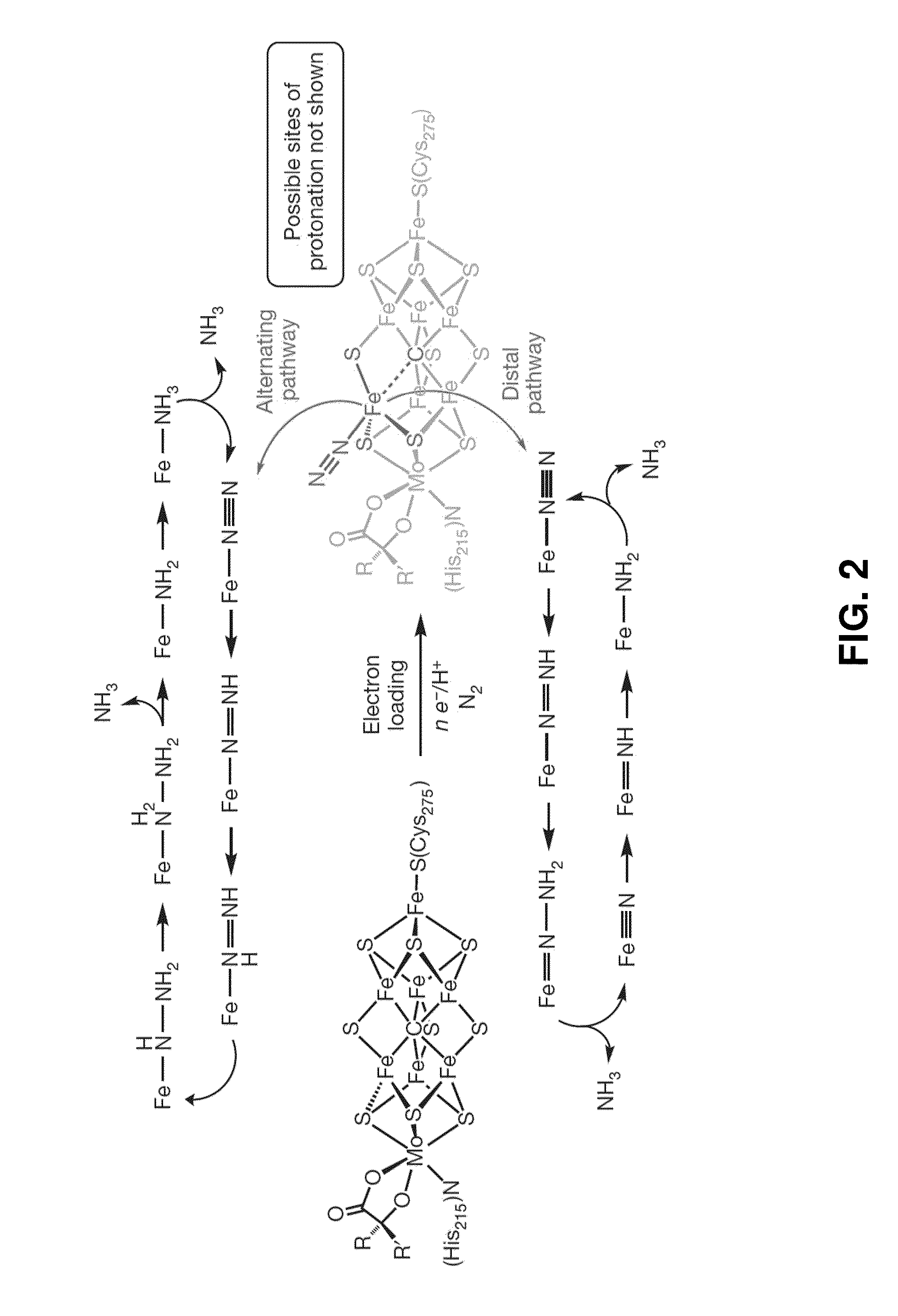Catalytic ammonia synthesis by transition metal molecular complexes
a technology of transition metals and complexes, which is applied in the direction of physical/chemical process catalysts, organic compounds/hydrides/coordination complexes catalysts, other chemical processes, etc., can solve the problems of resource-intensivehaber-bosch process and the exact mechanism of biological reduction of nitrogen to ammonia remains uncertain, and achieves good turnover ratio and reduction product yield, efficient conversion of molecular nitrogen, and use of catalytic efficiency
- Summary
- Abstract
- Description
- Claims
- Application Information
AI Technical Summary
Benefits of technology
Problems solved by technology
Method used
Image
Examples
example 1
Catalytic Conversion of Nitrogen to Ammonia by a Molecular Fe Model Complex
[0177]Nitrogen reduction to NH3 is a requisite transformation for life.1 While it is widely appreciated that the Fe-rich cofactors of nitrogenase enzymes facilitate this transformation,2,3,4,5 how they do so remains poorly understood. A central element of debate has been the site(s) of nitrogen coordination and reduction.6,7 The synthetic inorganic community placed an early emphasis on Mo8 because Mo was thought to be an essential element of nitrogenases,3 and because pioneering work by Chatt and his coworkers established that well-defined Mo model complexes could mediate the stoichiometric conversion of coordinated N2 to NH3.9 Indeed, such a transformation has now been validated in a catalytic fashion by two well-defined molecular systems that feature Mo centres.10,11 It is now thought that Fe is the only transition metal essential to all nitrogenases,3 and recent biochemical and spectroscopic data has impli...
example 2
Catalytic Reduction of N2 to NH3 b an Fe—N2 Complex Featuring a C-Atom Anchor
Abstract
[0276]While recent spectroscopic studies have established the presence of an interstitial carbon atom at the center of the iron-molybdenum cofactor (FeMoco) of MoFe-nitrogenase, its role is unknown. In this Example we pursue Fe—N2 model chemistry to characterize whereby this C-atom (previously denoted as a light X-atom) may provide a flexible trans interaction with an Fe center to expose an Fe—N2 binding site. This Example, describes Fe complexes of a new tris(phosphino)alkyl (CPiPr3) ligand featuring an axial carbon donor. It is established that the iron center in this scaffold binds dinitrogen trans to the Calkyl-atom anchor in three distinct and structurally characterized oxidation states. Fe—Calkyl lengthening is observed upon reduction, reflective of significant ionic character in the Fe—Calkyl interaction. The anionic (CPiPr3)FeN2− species can be functionalized by a silyl electrophile to gener...
example 3
Conversion of Fe—NH2 to Fe—N2 with Release of NH3
[0443]Tris(phosphine)borane ligated Fe(I) centers featuring N2H4, NH3, NH2, and OH ligands are described herein. The conversion of Fe—NH2 to Fe—NH3+ by addition of acid, and subsequent reductive release of NH3 to generate Fe—N2, is demonstrated. This sequence models the final steps of proposed Fe-mediated nitrogen fixation pathways. The five-coordinate trigonal bipyramidal complexes described are unusual in that they adopt S=3 / 2 ground states and are prepared from a four-coordinate, S=3 / 2 trigonal pyramidal precursor.
[0444]Due the structural and mechanistic complexity of biological nitrogen fixation1 a variety of mechanisms have been proposed that invoke either Mo or Fe as the likely active site for N2 binding and reduction. Fe—NH2 is an intermediate common to both limiting mechanisms (i.e., distal vs. alternating) being considered for Fe-mediated N2 fixation scenarios at the FeMo-cofactor.2,3 Such a species may form either via reduc...
PUM
| Property | Measurement | Unit |
|---|---|---|
| Molar density | aaaaa | aaaaa |
| Molar density | aaaaa | aaaaa |
| Molar density | aaaaa | aaaaa |
Abstract
Description
Claims
Application Information
 Login to View More
Login to View More - R&D
- Intellectual Property
- Life Sciences
- Materials
- Tech Scout
- Unparalleled Data Quality
- Higher Quality Content
- 60% Fewer Hallucinations
Browse by: Latest US Patents, China's latest patents, Technical Efficacy Thesaurus, Application Domain, Technology Topic, Popular Technical Reports.
© 2025 PatSnap. All rights reserved.Legal|Privacy policy|Modern Slavery Act Transparency Statement|Sitemap|About US| Contact US: help@patsnap.com



